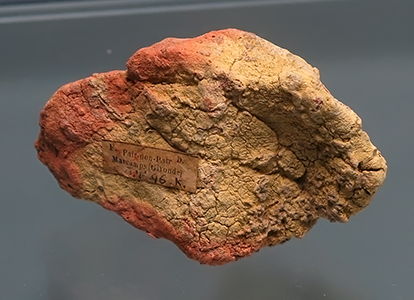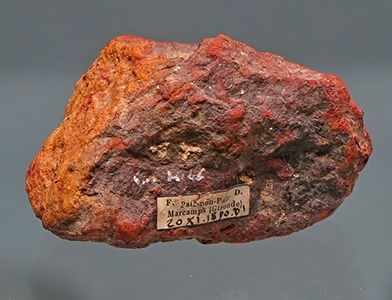Back to Don's Maps
Grotte de Pair-non-Pair
Discovered in 1881, the cave of Pair-non-Pair contains engravings (featuring horses, ibexes, cervidae, mammoths) which rank among the most ancient examples of art made by prehistoric man (between 33 000 and 26 000 years old). Prehistoric objects and artefacts discovered at the Pair-non-Pair Caves are on display in a special museum section.
Text above: Owner's description

Pair-non-Pair Entrance
Photo: unknown
Source: http://fr.wikipedia.org/wiki/Grotte_de_Pair-non-Pair

Old postcard of the present entrance to Pair-non-Pair.
In the foreground is Pierre Macouillard, owner and guide of the cave in the 1950s.
Photo: Gil Duporge
Permission: Creative Commons Attribution-Share Alike 3.0 Unported license
My sincere thanks to Monsieiur Gil Duporge, who brought the book Cheynier (1963) to my attention, (see the foot of this page for the photographs of the casts which were made at that time) and was so kind as to send me historical photographs of the early times at the cave.
He writes, in part:
The actors of the adventure of Pair-non-Pair were my family, the owner Baptiste Milepied then Pierre Macouillard his employee, who became his son-in-law and was my great grandfather.
When I was a child, my mother showed visitors the cave with a candleholder. It revealed these exceptional engravings, there were some magical properties of this method of discovering the cave, we do not find this wonder now with electric light, and the speed of the visit.
My brothers and I brought the visitors up to the cave through the vineyards (there was no road at the time in 1961/1968) People tipped us for some flints or shards of Gallo-Roman pottery picked up in the vineyard of my grandfather.
The Grotto is named after my family house 'Pair-Non-Pair', people parked in front of the gate of the house, which included two Gallo-Roman stones in its construction. The book Cheynier (1963) was given to my mother to thank her for her help in its production.
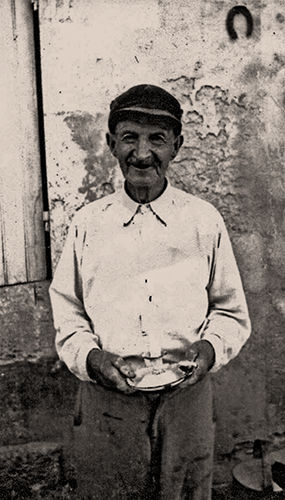
Photo of Pierre Macouillard with the candlestick that served as a light for visitors to the cave.
Photo and text: Courtesy M. Gil Duporge
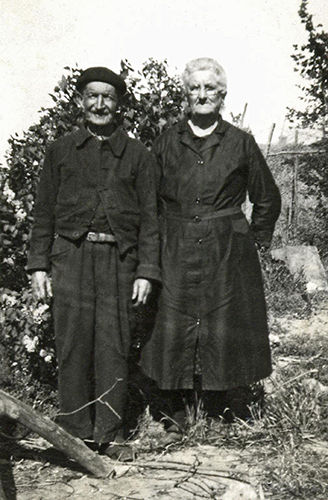
Photo of Pierre Macouillard and Marguerite Milepied his wife, daughter of Baptiste Milepied, one of the first owners of the cave.
Pierre Macouillard was my great grandfather, and actively participated in the excavation of the cave under the direction of François Daleau.
He was the owner and guardian of the Grotto until his death in 1955.
Photo and text: Courtesy M. Gil Duporge

This is the present door to the cave. The original entrance was via what is called the corridor, which collapsed in the Châtelperronian, between 35 000 and 29 000 BP masking the original entrance to the cave.
The original entrance was then replaced by several secondary entrances which have since disappeared due to sedimentation. The cave was found almost completely covered by debris and sediment.
In 1881, a cow grazing in the meadow got its leg stuck in a hole. The employee of Mr. Barberin, owner of the land, discovered the cave when rescuing the cow. it had uncovered a hole in the roof of the Chamber of Engravings of Pair-non-Pair.
Photo: © Joelle
Source: http://2013bordeauxsabbatical.blogspot.com.au/2013/10/la-grotte-de-pair-non-pair-et-le.html
Text: Adapted from Wikipedia
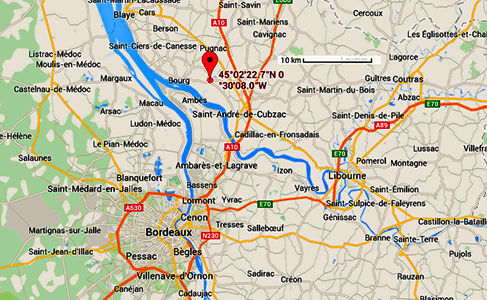
Location map
Photo: Google Maps
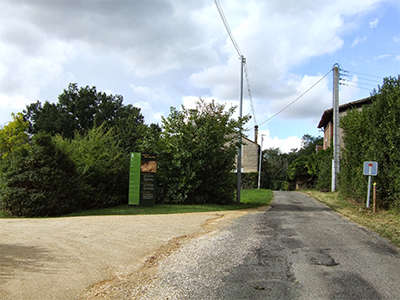
Entry to the parking area at Pair-non-Pair, off a narrow road.
Photo: © Joelle
Source: http://2013bordeauxsabbatical.blogspot.com.au/2013/10/la-grotte-de-pair-non-pair-et-le.html
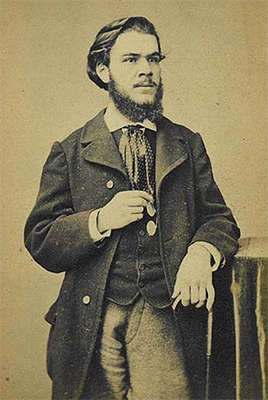
François Daleau 1870
La grotte de Pair-non-Pair was discovered in 1881 by François Daleau. The engravings, which at the time were completely covered by archaeological layers were recognised in 1896.
Pair-non-Pair was the third decorated cave discovered in the world, its authenticity was never questioned, and it became one of the major arguments for the recognition of prehistoric art.
Human occupation of the cave can be divided into the Mousterian (~80 000 BP), the Chatelperronian (~40 000 BP), the Aurignacian (~30 000 BP) and the Gravettian (~25 000 BP).
Photo: http://www.usaquitaine.com/article11122010.htm
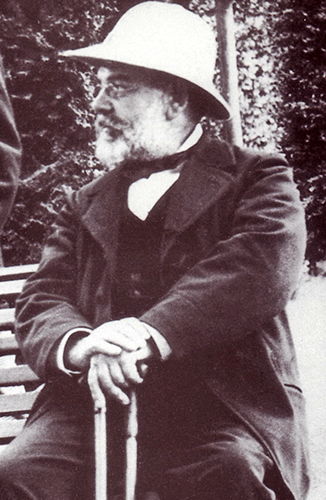
François Daleau
Photograph taken on 23rd June 1901, at his property Bourg.
A leader in the development of scientific methods of excavation and the recording of archaeological sites, François Daleau's notebooks carefully document all his comments on the stratigraphy of the layers, and the distribution of the objects found there.
He bequeathed thousands of flint tools, faunal remains, ornaments, and worked bones to the city of Bordeaux in 1927 and the 'Daleau Collection' remains a major part of the treasures of the Musée d'Aquitaine, and is still studied today.
Photo: Unknown
Permission: Public Domain
Source: Wikipedia
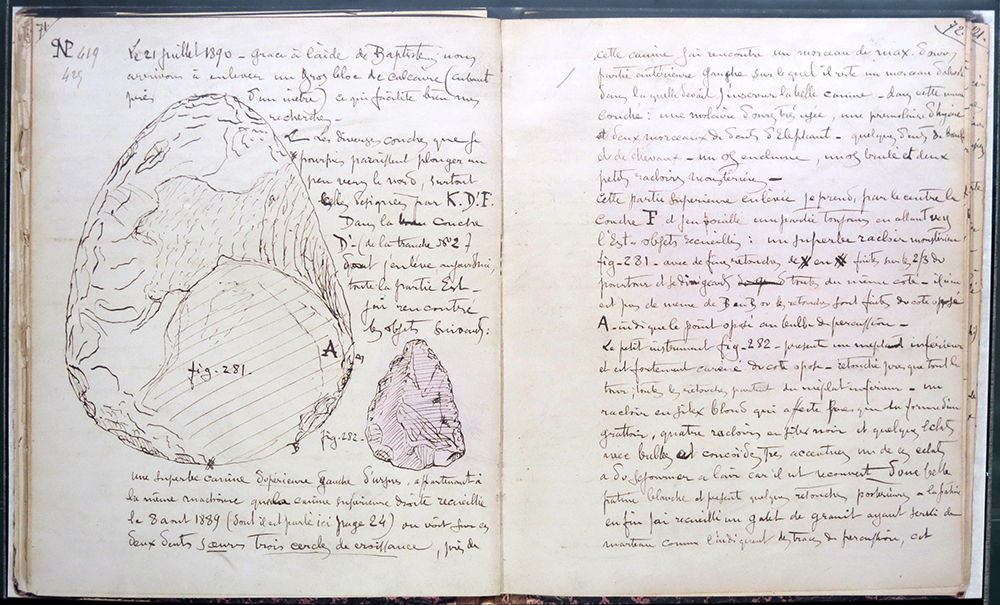
François Daleau's journal notes of his excavations at Pair-non-Pair.
Photo: Don Hitchcock 2015
Source: Facsimile, Musée d'Aquitaine à Bordeaux
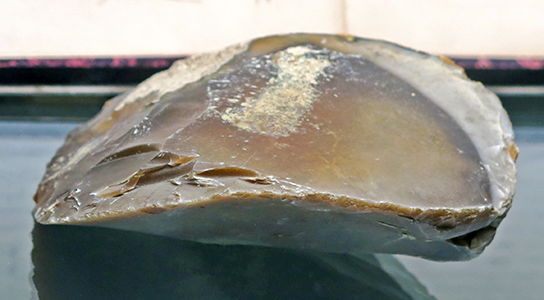
This Mousterian racloir is the one described in the journal entry above.
Photo: Don Hitchcock 2015
Source and text: Original, Musée d'Aquitaine à Bordeaux
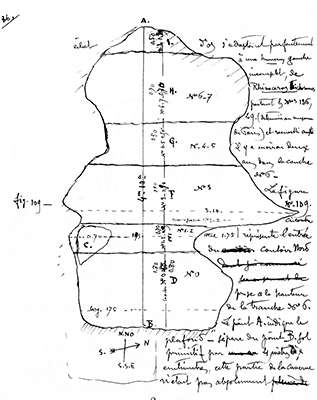

Plan and elevation of the 1881 excavation by François Daleau.
Photo: Leroi-Gourhan (1984)
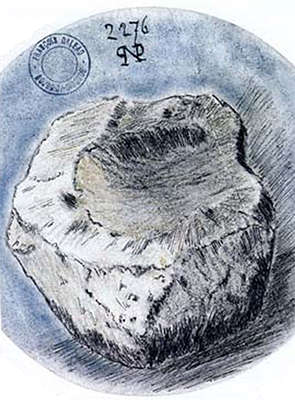
Lamp from Pair-non-Pair.
Photo: Marie Gachet
Source: http://www.usaquitaine.com/article11122010.htm

Flute with three holes, made from the bone of a bird's wing, from Pair-non-Pair.
Photo: http://www.hominides.com/html/lieux/musee-aquitaine-prehistoire-bordeaux.php
Source: original, display at Musée d'Aquitaine

Engraved bear rib from Pair-non-Pair.
Age: Aurignacian or Gravettian
Photo: Don Hitchcock 2015
Source and text: Original, Musée d'Aquitaine à Bordeaux

Engraved horse metatarsal from Pair-non-Pair.
Age: Aurignacian or Gravettian
Photo: Don Hitchcock 2015
Source and text: Original, Musée d'Aquitaine à Bordeaux

Reindeer metacarpal engraved and treated with ochre.
Age: Aurignacian or Gravettian
Photo: Don Hitchcock 2015
Source and text: Original, Musée d'Aquitaine à Bordeaux

'Headband' in ivory from Pair-non-Pair, above the reindeer metacarpal. Its actual use remains unknown.
Age: Aurignacian or Gravettian
Photo: Don Hitchcock 2015
Source and text: Original, Musée d'Aquitaine à Bordeaux

Decorated bone lissoir, a polisher and stretcher used in the preparation of hides.
Age: Aurignacian or Gravettian
Photo: Don Hitchcock 2015
Source and text: Original, Musée d'Aquitaine à Bordeaux

Carved spear point.
Age: Aurignacian or Gravettian
Photo: Don Hitchcock 2015
Source and text: Original, Musée d'Aquitaine à Bordeaux
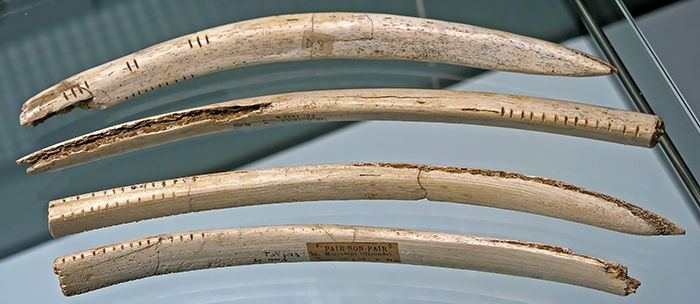
Carved ribs.
Age: Aurignacian or Gravettian
Photo: Don Hitchcock 2015
Source and text: Original, Musée d'Aquitaine à Bordeaux
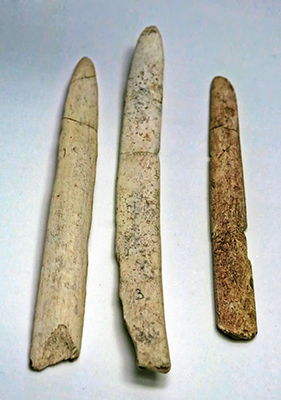
Lissoirs from Pair-non-Pair and Cap Blanc.
(left) Bone lissoir from Pair-non-Pair, 60.1060.4, Daleau collection.
(centre) Bone lissoir from Pair-non-Pair, 60.1060.5, Daleau collection.
(right) Reindeer antler lissoir from Cap Blanc, 61.3.306.
Photo: Don Hitchcock 2015
Catalog: 60.1060.4, 60.1060.5, 61.3.306
Source: Original, Musée d'Aquitaine à Bordeaux

Carnivore tooth, possibly of a cave lion, Pair-non-Pair.
Photo: Don Hitchcock 2015
Source and text: Original, display at Musée d'Aquitaine à Bordeaux
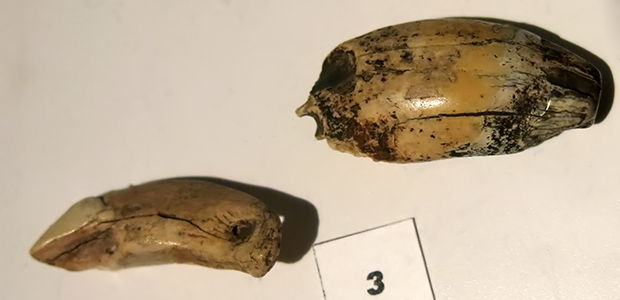
Hyena canine and incisor teeth from Pair-non-Pair.
Age: Aurignacian or Gravettian.
Photo: Don Hitchcock 2015
Catalog: 60.1050.59 and 60.1060.150
Source and text: Original, display at Musée d'Aquitaine à Bordeaux
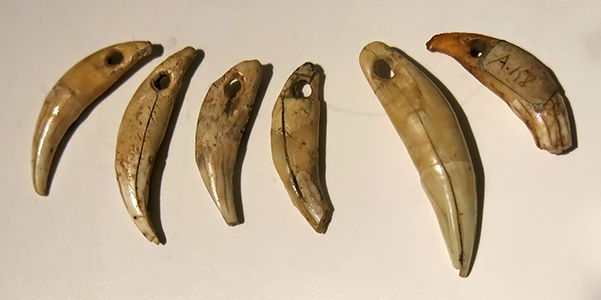
Pierced fox canine teeth from Pair-non-Pair, Prignac-et-Marcamps and Les Jean-Blancs, Bayac.
Age: Aurignacian or Gravettian or Solutrean.
Photo: Don Hitchcock 2015
Catalog: 60.1048.67 and 60.476.191
Source and text: Original, display at Musée d'Aquitaine à Bordeaux
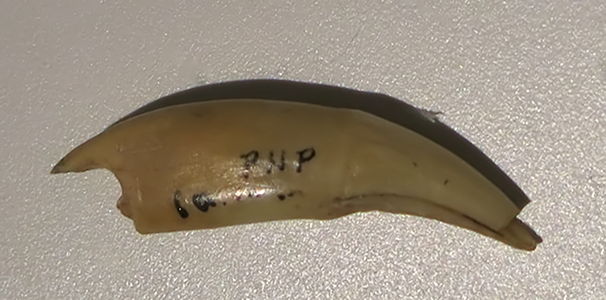
Pierced lynx canine tooth from Pair-non-Pair.
Age: Aurignacian or Gravettian.
Photo: Don Hitchcock 2015
Catalog: 60.1060.157
Source and text: Original, display at Musée d'Aquitaine à Bordeaux

Pierced horse incisor teeth from Pair-non-Pair and Les Jean-Blancs, Bayac.
Age: Recent Palaeolithic and Gravettian.
Photo: Don Hitchcock 2015
Catalog: 60.1046.124 and 60.476.198
Source and text: Original, display at Musée d'Aquitaine à Bordeaux
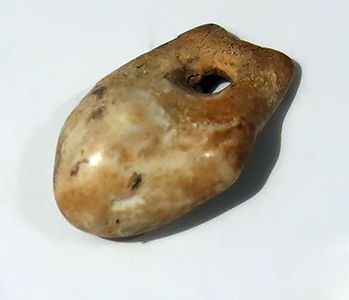
Pierced megaloceros canine tooth from Pair-non-Pair.
Age: Recent Palaeolithic.
Photo: Don Hitchcock 2015
Catalog: 60.1060.25
Source and text: Original, display at Musée d'Aquitaine à Bordeaux
The Mousterian flint tools from Pair-non-Pair shown in the images immediately below include:
• Racloirs - a type of side scraper distinctive of Mousterian assemblages. It is created from a flint flake and looks like a large scraper. As well as being used for scraping hides and bark, it may also have been used as a knife. Racloirs are most associated with the Neanderthal Mousterian industry.
• Mousterian points - the Levallois technique involving the striking of flakes from a prepared core.
• Grattoirs (scrapers) on flakes retouched at one end.
• Bifaces - hand axes in the Mousterian tradition.
Note that the individual tools were not named in the display case. The identifications below are my interpretations of their functions.


Mousterian flint tools from Pair-non-Pair.
Two racloirs.
On the right, Catalog: 60.1045.7
Photo: Don Hitchcock 2015
Source: Original, Musée d'Aquitaine à Bordeaux

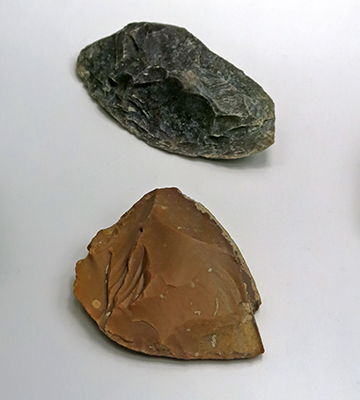
Mousterian flint tools from Pair-non-Pair.
Biface at left, racloir at the top right, point at bottom right.
Biface catalog: 60.1045.2.
Photo: Don Hitchcock 2015
Source: Original, Musée d'Aquitaine à Bordeaux
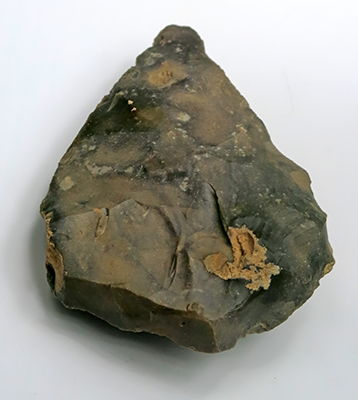
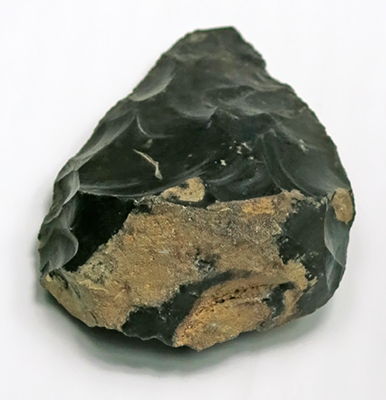
Mousterian flint tools from Pair-non-Pair.
Two biface hand axes.
Biface at right: Catalog: 60.1045.1
Photo: Don Hitchcock 2015
Source: Original, Musée d'Aquitaine à Bordeaux

Mousterian flint tools from Pair-non-Pair.
Three points.
Photo: Don Hitchcock 2015
Source: Original, Musée d'Aquitaine à Bordeaux

Mousterian flint tools from Pair-non-Pair.
From left to right, a grattoir, a combination grattoir and racloir, and a racloir.
Photo: Don Hitchcock 2015
Source: Original, Musée d'Aquitaine à Bordeaux

Mousterian retoucher in bone, used for striking flakes from flint to create specific tools.
Photo: Don Hitchcock 2015
Source: Original, Musée d'Aquitaine à Bordeaux
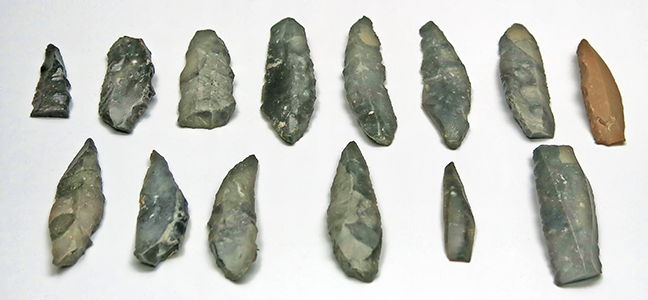
Châtelperronian flint points and knives from Pair non Pair.
Photo: Don Hitchcock 2015
Source and text: Original, Musée d'Aquitaine à Bordeaux

Aurignacian tools from Pair non Pair.
Keeled scrapers, scrapers on blades, blades.
Photo: Don Hitchcock 2015
Source and text: Original, Musée d'Aquitaine à Bordeaux
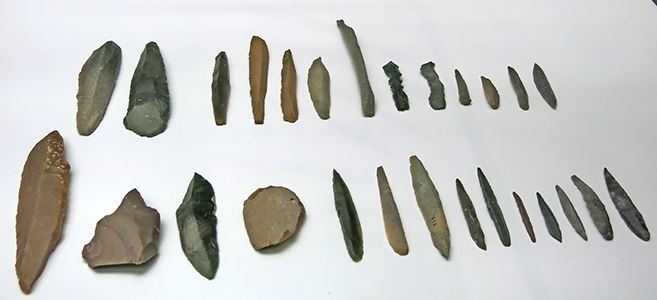
Gravettian tools from Pair non Pair.
Points, microgravettes, scrapers, burins, retouched blades.
Photo: Don Hitchcock 2015
Source and text: Original, Musée d'Aquitaine à Bordeaux
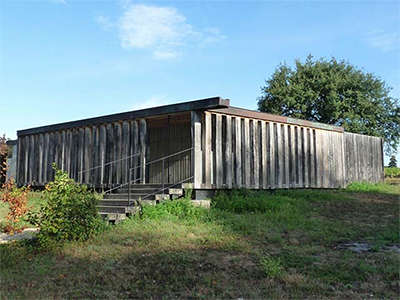
Visitors Centre
Photo: http://www.usaquitaine.com/article11122010.htm
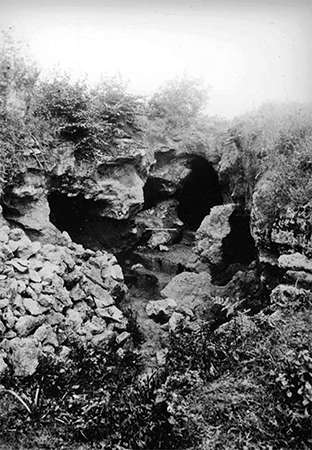
Excavation of the corridor in 1897.
Photo: Th. Amtmann, 1897 - Musée d'ethnographie, Bordeaux
Source: http://www.usaquitaine.com/article11122010.htm
There were two major periods of occupation of the cave.Text above: http://www.hominides.com/html/lieux/grotte-pair-non-pair.php
The cave was occupied for 60 000 years, including the time of the carving of the engravings. Seven layers of occupations were distinguished by François Daleau.
At 80 000 BP it was first occupied by Neanderthals. 40 000 years ago the first part of the cave, the 'Corridor' collapsed, greatly reducing the sheltered area.
At this point modern man gained access using another entry. The engravings are dated to between 35 000 BP, to 22 000 BP. They are attributed to the Aurignacian. Researchers have identified 46 prints, of which only about a dozen are faithfully preserved because of sedimentation in the cave.
The animals which are shown on the walls are not those they hunted. They hunted and consumed mainly reindeer, which is not a species represented in the engravings.
A few traces of ochre indicate that the engravings may originally have been coloured. Of the animals identified, 11 are Ibex, 6 are Horses, 4 are Aurochs, 4 are Deer, and there are 4 mammoths, and one Megaloceros engraving.
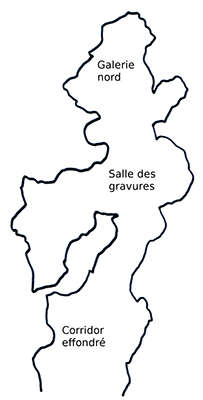

Plan of Pair-non-Pair
Photo: unknown
Source: http://fr.wikipedia.org/wiki/Grotte_de_Pair-non-Pair
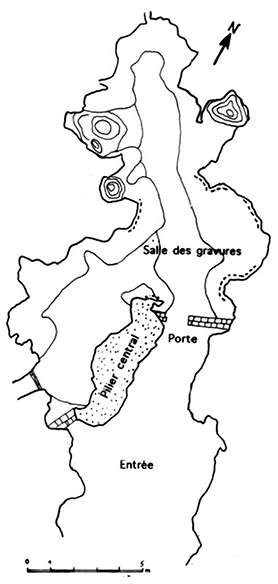
Plan of the cave as it exists now.
Note that the wall and door to the cave has been moved to the entrance to the Salle des Gravures.
Photo: Dubourg et al. (1996)
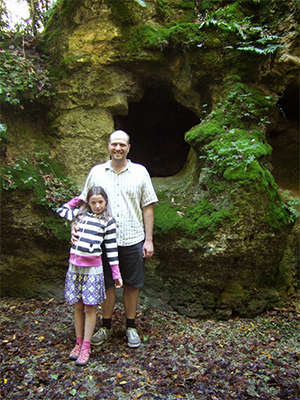
This is the entrance to Pair-non-Pair used by the artists who carved the engravings.
Photo: © Joelle
Source: http://2013bordeauxsabbatical.blogspot.com.au/2013/10/la-grotte-de-pair-non-pair-et-le.html
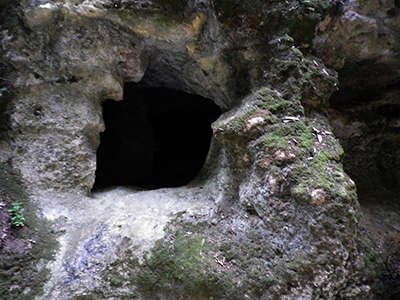
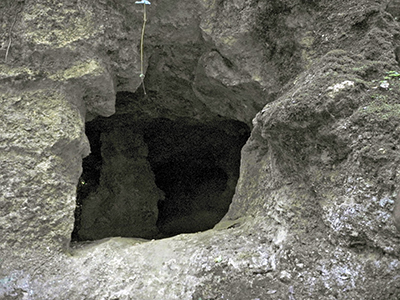
Another view of the entrance to Pair-non-Pair used by the artists who carved the engravings.
Photo: (left) http://alexdebordeaux.wordpress.com/2011/06/17/, (right) Courtesy Elise Meyer
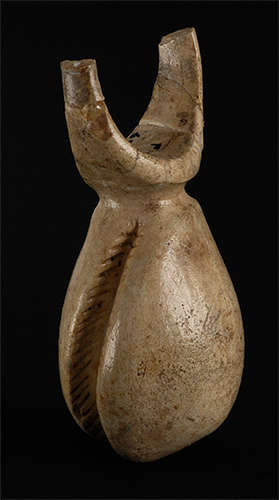
Pendant in the shape of a cowrie, Pair-non-Pair cave
Prignac-et-Marcamps (Gironde). Gravettian, around 25000 B.P. Ivory. Inv. 60.1060.33.
This ivory pendant is in the shape of a cowrie, an animal characteristic of tropical climates. Its Gravettian creator copied fossils present in the Aquitainian subsoil. Prehistoric people made personal ornaments, pendants and beads from shells and fossils. The scarcity of fossilised cowries must have made this type of shell very valuable, which inspired the craftsman to make a copy from mammoth ivory. The suspension ring is broken, which may explain why such an object of personal decoration was abandoned in the cave of Pair-non-Pair.
This is currently the only known European example of the prehistoric reproduction of a fossilised cowrie.
Photo and text: http://www.musee-aquitaine-bordeaux.fr/en/article/pendant-shape-cowrie-pair-non-pair-cave
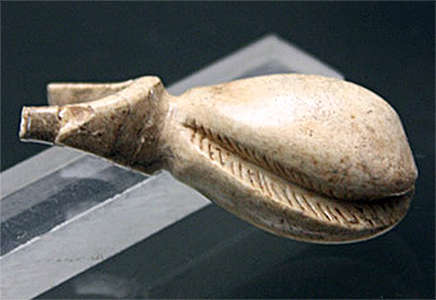
Another view of the ivory pendant in the shape of a cowrie shell, Cypraeidae, from Pair-non-Pair.
Photo: http://www.hominides.com/html/lieux/musee-aquitaine-prehistoire-bordeaux.php
Source: original, display at Musée d'Aquitaine
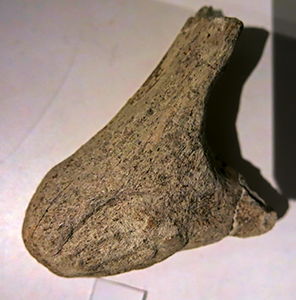
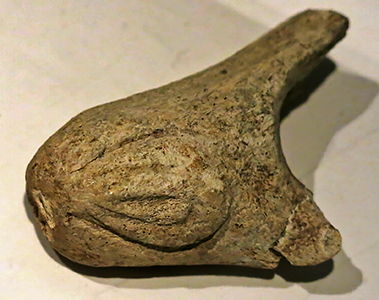
Engraved vulva from Pair-non-Pair.
Material: Reindeer antler
Age: Recent Palaeolithic
Catalog: 60.1070.2
Photo: Don Hitchcock 2015
Source: Original, Musée d'Aquitaine à Bordeaux

Plan of the engravings.
2-15: First panel on the right wall.
16-19: Second panel, known as Agnus Dei
23-24: Mammoth
26-31: Third Panel
38: Small isolated mammoth
49-56: Large panel on the left wall
Photo: Delluc et al. (1997)
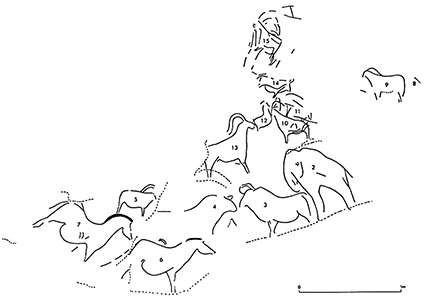
First panel on the right wall, figures 2 to 15.
Photo: Delluc et al. (1997)

Agnus Dei panel, figures 16 to 19, 23 and 24.
Photo: Delluc et al. (1997)
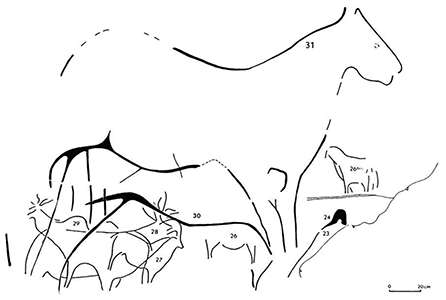
Third panel, on the right wall. Figures 26 to 31, on the edge of the panel is the mammoth 23-24.
Photo: Delluc et al. (1997)
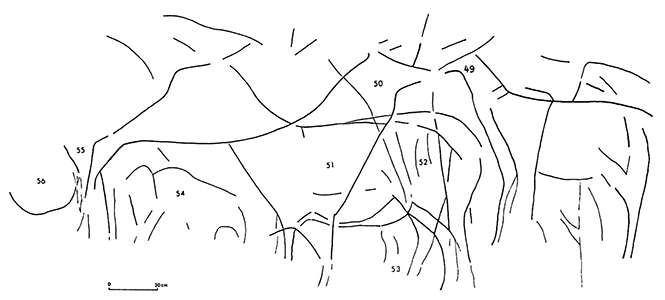
Large Panel on the left wall, figures 49 to 56.
Photo: Delluc et al. (1997)

Mammoth engraving.
Photo: unknown
Source: http://fr.wikipedia.org/wiki/Grotte_de_Pair-non-Pair
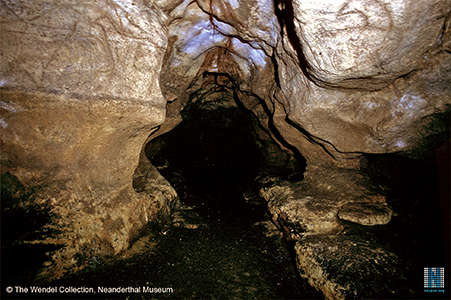
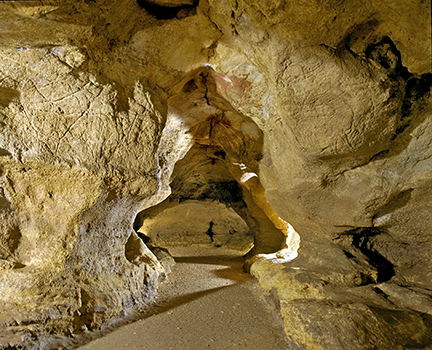
Looking towards the Galerie Nord and the far end of the cave.
Ibex (left wall, 49) and Horse (right wall, 'Agnus Dei', 16)
Photo (left): Heinrich Wendel (© The Wendel Collection, Neanderthal Museum)
Photo (right): http://www.tripadvisor.com.au/Attraction_Review-g1939236-d2397775-Reviews-Grotte_de_Pair_non_Pair-Prignac_Et_Marcamps_Gironde_Aquitaine.html
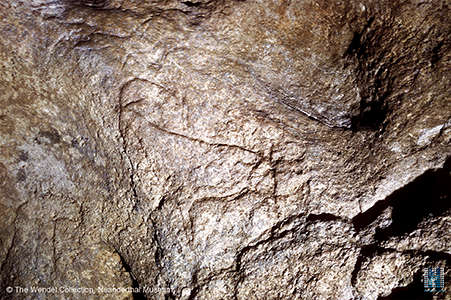
Ibex engraving.
Photo: Heinrich Wendel (© The Wendel Collection, Neanderthal Museum)
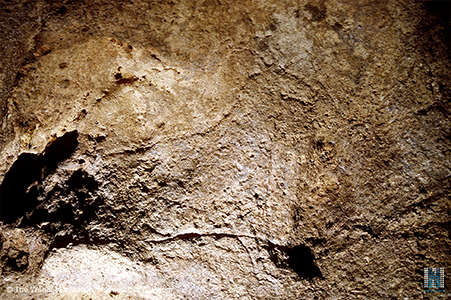
Horse engraving.
Photo: Heinrich Wendel (© The Wendel Collection, Neanderthal Museum)
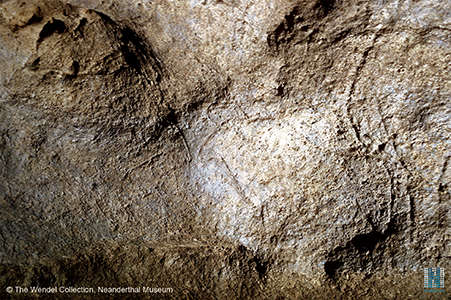

Bison engraving.
Photo: Heinrich Wendel (© The Wendel Collection, Neanderthal Museum)
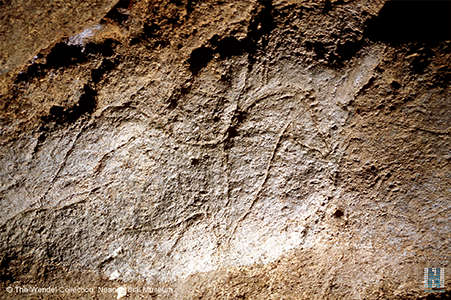
Horse engraving.
Photo: Heinrich Wendel (© The Wendel Collection, Neanderthal Museum)
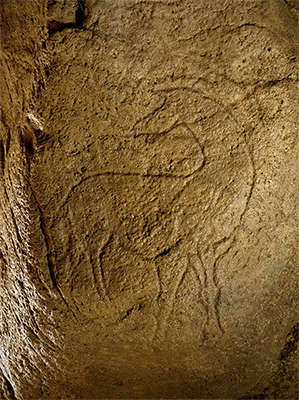
Engraving of a horse looking over its shoulder.
Photo: http://www.usaquitaine.com/article11122010.htm

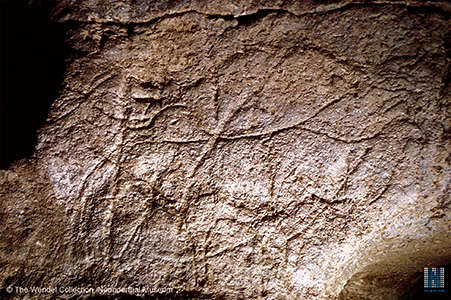
Megaloceros and Ibex engraving.
Photo: Heinrich Wendel (© The Wendel Collection, Neanderthal Museum)
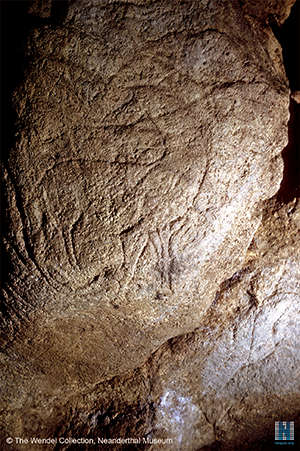
Horse engraving, as above. It is known as Agnus Dei, or Lamb of God.
Photo: Heinrich Wendel (© The Wendel Collection, Neanderthal Museum)
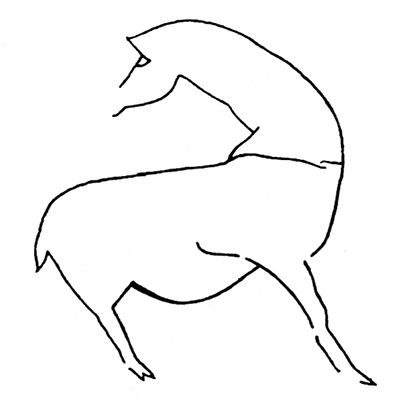
This is the traditional interpretation of the Agnus Dei horse engraving. David et Malvesin-Fabre (1950) decided to investigate the engraving using artificial light, set up in various ways, to bring out any extra lines of engraving, invisible when the engraving is lit from straight ahead.
They found that there was evidence that the engraving was actually of two animals, a horse and an ibex, facing in opposite directions. They write:
We decided to undertake a careful study which revealed other imperfections: the rump is not that of a horse, the tail is very short, and the legs do not resemble those of a horse but rather those of an ibex. Together with these findings, we also noticed that this engraving is eye catching because it is just opposite the current entrance to the cave, and this is where it receives direct light which gives it the classic appearance on arrival in the cave. We therefore tried several differing lighting setups using artificial light. A photograph was made for each lighting mode.
Photo and adapted text: David et Malvesin-Fabre (1950)
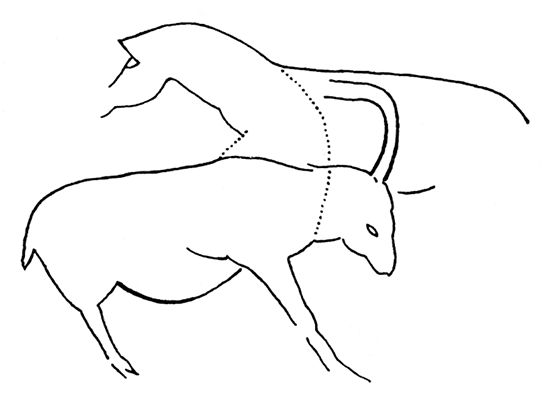
Following these tests we came to the following conclusions:
The neck and head do not belong to the same drawing as the body. The latter continues in the other direction to the lowered head of an ibex whose horns are clearly indicated. This head is perfectly connected with the neck in the position of a grazing animal. It is the line of the neck that Daleau noticed, delineating the neck of the equine animal, according to his interpretation.
It is clear to us that the ibex is a pregnant, which explains the moderate development of the horns, since it is a female.
Photo and adapted text: David et Malvesin-Fabre (1950)
(note that in my opinion, if the writers, David et Malvesin-Fabre (1950) are correct, someone has, at a later date, come through and added extra grooves to link the two animals into the familiar and iconic shape. The writers ignore the clear and distinct lines joining the head and body of the 'horse' - Don )

Pair-non-Pair cave (Marcamps, Gironde).
Engraved panel with ibex (27), red deer (28) and giant deer (29).
Photo and text: Jaubert (2008)
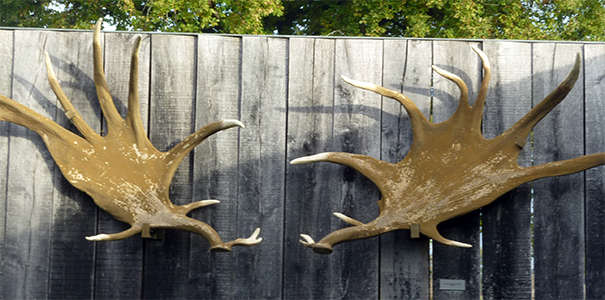
Megaloceros antlers (facsimile) on the wall of the Visitors Centre at Pair-non-Pair.
Photo: http://tice33.ac-bordeaux.fr/
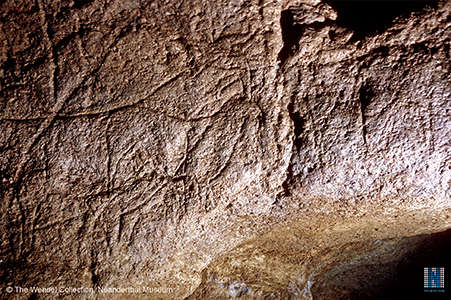
Ibex engraving.
Photo: Heinrich Wendel (© The Wendel Collection, Neanderthal Museum)
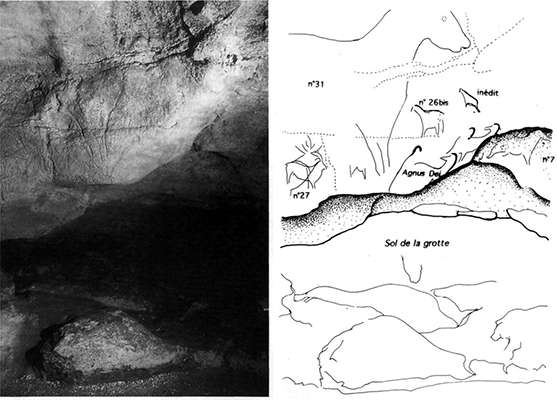
This photo and drawing notes the discovery of a new unpublished (inédit) Ibex.
Photo: Dubourg et al. (1996)

Closeup of the new unpublished Ibex.
Photo: Dubourg et al. (1996)
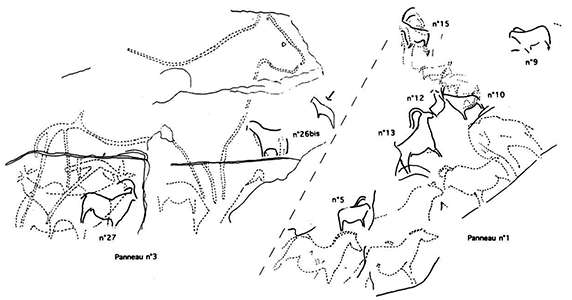
Arrangement of Ibexes at Pair-non-Pair.
Photo: Dubourg et al. (1996)

The two styles of Ibex representation at Pair-non-Pair.
Photo: Dubourg et al. (1996)
Engravings from Pair-non-Pair.
Artwork by M. Daleau
Photo and text: Cartailhac et Breuil (1906)
Dubourg et al. (1996) state that at Pair-non-Pair there are at present:
10 Ibex (plus one doubtful)
5 Horses (plus one doubtful)
4 Cervids (three Deer and one Megaloceros)
3 Bovids (plus one doubtful)
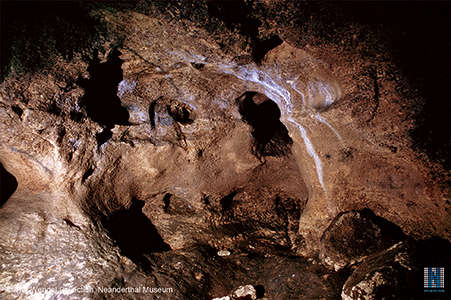
Wall carved by water when the cave was originally formed.
Photo: Heinrich Wendel (© The Wendel Collection, Neanderthal Museum)
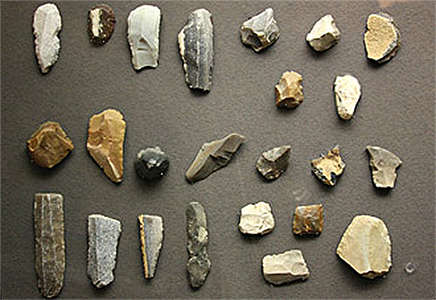
Flint tools from the Aurignacian from Pair-non-Pair.
Photo: http://www.hominides.com/html/lieux/musee-aquitaine-prehistoire-bordeaux.php
Source: original, display at Musée d'Aquitaine
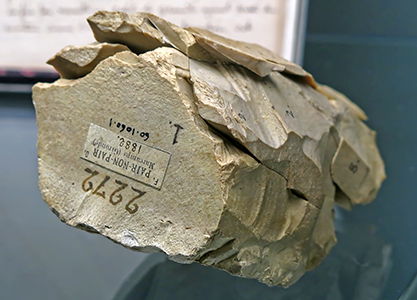
Gravettian flint core and flakes from Pair-non-Pair.
Length 138mm, width 115 mm, thickness 75mm
Photo: Don Hitchcock 2015
Catalog: 60.1060.1
Source and text: Original, Musée d'Aquitaine à Bordeaux
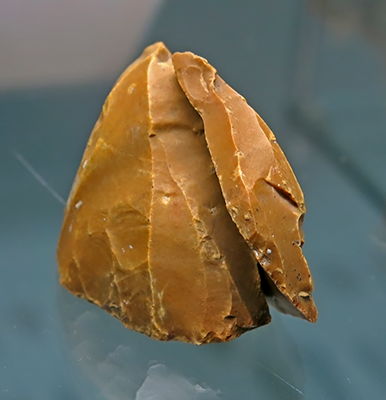

Cores reassembled with the blades struck from them.
Photo: Don Hitchcock 2015
Source and text: Original, display at Musée d'Aquitaine à Bordeaux

Core reassembled with the blades struck from it.
Photo: Don Hitchcock 2015
Catalog: 60.1046.21
Source and text: Original, display at Musée d'Aquitaine à Bordeaux

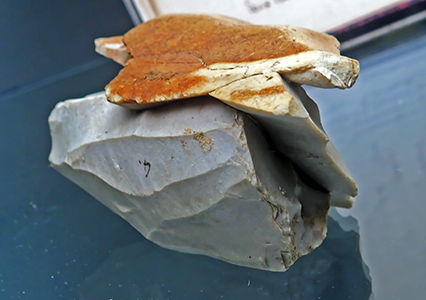
Cores reassembled with the blades struck from them.
Photo: Don Hitchcock 2015
Source and text: Original, display at Musée d'Aquitaine à Bordeaux

Jasper core with a blade struck from it on the far side of the image. This was reassembled by François Daleau.
Photo: Don Hitchcock 2015
Catalog: 60.1060.36
Source and text: Original, Musée d'Aquitaine à Bordeaux

Nucléus à lames, core from which blades have been struck, Pair-non-Pair, Prignac-et-Marcamps (33)
Photo: Don Hitchcock 2015
Catalog: Flint, 60.1046.59
Source and text: Original, Musée d'Aquitaine à Bordeaux
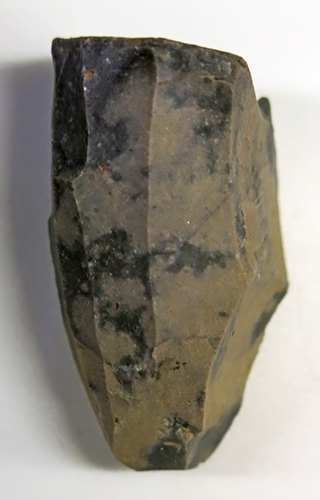
Nucléus à lamelles, core from which bladelets have been struck, Pair-non-Pair, Prignac-et-Marcamps (33)
Photo: Don Hitchcock 2015
Catalog: Flint, 60.1046.97
Source and text: Original, Musée d'Aquitaine à Bordeaux

Mammoth ivory flakes from Pair-non-Pair.
Photo: http://www.hominides.com/html/lieux/musee-aquitaine-prehistoire-bordeaux.php
Source: original, display at Musée d'Aquitaine
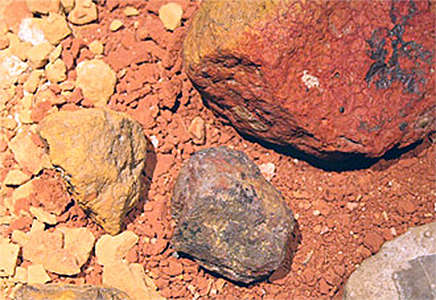
Red and yellow ochre dating to the Gravettian from Pair-non-Pair.
Photo: http://www.hominides.com/html/lieux/musee-aquitaine-prehistoire-bordeaux.php
Source: original, display at Musée d'Aquitaine
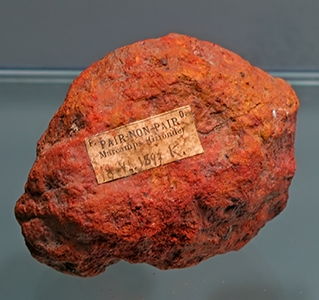
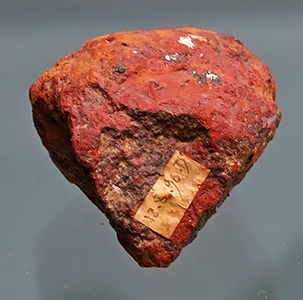
Ochre from Pair-non-Pair, Prignac-et-Marcamps
Age: Gravettian
Photo: Don Hitchcock 2015
Source and text: Original, display at Musée d'Aquitaine à Bordeaux
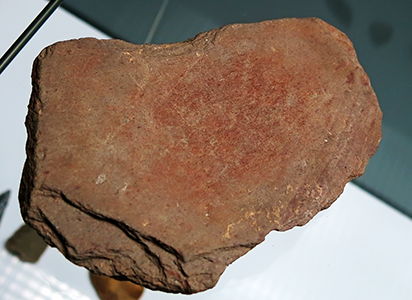
Schist plate with traces of ochre from being used as a palette.
Length 210 mm, width 140 mm, thickness 18 mm.
Recent Palaeolithic
Photo: Don Hitchcock 2015
Source and text: Original, display at Musée d'Aquitaine à Bordeaux

Bovid left scapula from Pair-non-Pair, decorated with ochre.
Photo: http://www.hominides.com/html/lieux/musee-aquitaine-prehistoire-bordeaux.php
Source: original, display at Musée d'Aquitaine

Bovid left scapula used as a palette for ochre.
From Pair-non-Pair, Prignac-et-Marcamps
Age: Gravettian
Photo: Don Hitchcock 2015
Source and text: Original, display at Musée d'Aquitaine à Bordeaux


Scapula in two pieces, formerly used as a palette for ochre.
From Pair-non-Pair, Prignac-et-Marcamps
Age: Recent Palaeolithic
Photo: Don Hitchcock 2015
Source and text: Original, display at Musée d'Aquitaine à Bordeaux

Pierced bison or aurochs teeth from Pair-non-Pair and Les Jean-Blancs, Bayac.
Recent Palaeolithic and Solutrean.
Catalog: 60.1060.154 and 60.476.193
Photo: Don Hitchcock 2015
Source: Original, display at Musée d'Aquitaine à Bordeaux
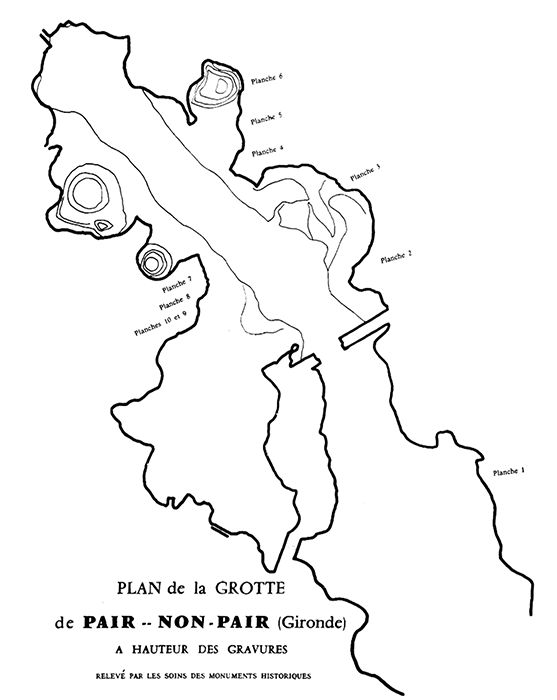
Plan of the Grotte de Pair-non-Pair at the level of the engravings.
Photo and text: Cheynier (1963)

L'Abbé Breuil at the entrance to la grotte de Pair-non-Pair, getting his acetylene lamps ready for use.
Photo: By R. L. Doize, from the Musée de l'homme collections
Source and text: Cheynier (1963)
According to Cheynier (1963), there are 59 animals represented at Pair-non-Pair, as a result of the painstaking work of Abbé Breuil. Dalcau had deciphered only 18. There are 14 horses, 12 bovids, 8 ibex, 5 mammoths, and 5 bears. Of deer, there are only one deer, one red deer, and one megaloceros, as well as a feline and a rhinoceros.

Cast 1, Number 3: Bison or bull, one metre.
Photo and text: Cheynier (1963)

Cast 2, Number 5: Ibex, 56 cm, Horse 120 cm.
Photo and text: Cheynier (1963)
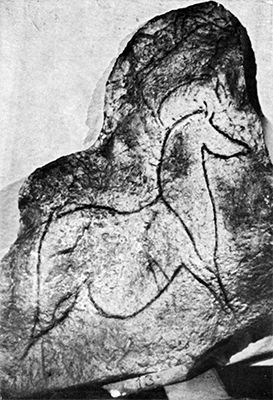
Cast 3, Number 7: Horse 120 cm.
Photo and text: Cheynier (1963)
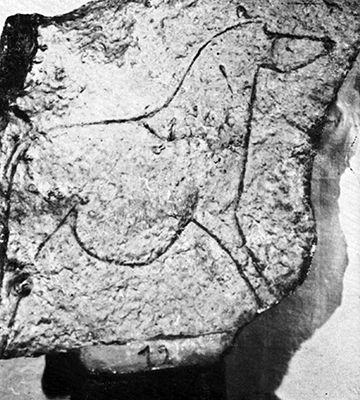
Cast 4, Number 6: Horse 100 cm.
Photo and text: Cheynier (1963)
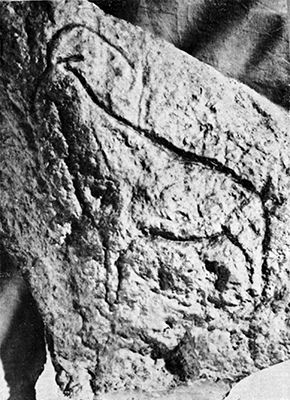
Cast 5, Number 10: A beautifully posed ibex, 40 cm.
Photo and text: Cheynier (1963)

Cast 6, Number 12: 20 cm
Photo and text: Cheynier (1963)
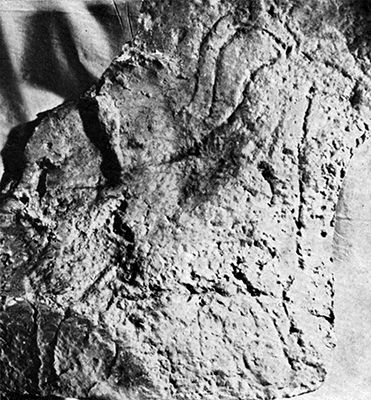
Cast 7, Number 13: Large ibex, 80 cm.
Photo and text: Cheynier (1963)
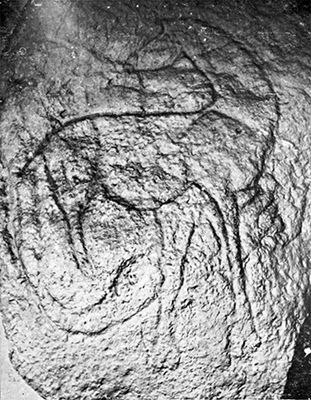
Cast 8, Number 16: Agnus Déi, height 190 cm.
Photo and text: Cheynier (1963)

Cast 10, Number 49
Photo and text: Cheynier (1963)
References
- Cartailhac, É., Breuil H., 1906: La Caverne d'Altamira a Santillane près Santander (Espagne) Imprimerie de Monaco, 1906.
- Cheynier A., 1963: La caverne de Pair - non-Pair (Gironde). Fouilles de François Daleau, Documents et industries étudiés et dessinés par le docteur André Cheynier, Préf. Raoul Cousté. Cheynier (Dr André) éd. & Abbé Breuil, Edité par Bordeaux, Société archéologique (Documents d'Aquitaine, II), 1963
- David P., Malvesin-Fabre G., 1950: Une interprétation nouvelle pour une gravure de Pair-non-Pair, Bulletin de la Société préhistorique de France, tome 47, no. 3-4, 1950. pp. 139-141.
- Delluc B., Delluc G., 1997: Dix observations graphiques sur la grotte ornée de Pair-Non-Pair (Prignac-et-Marcamps, Gironde), Bulletin de la Société préhistorique française, 1997, tome 94, N. 1. pp. 41-50.
- Dubourg C., Martinez M., Aujoulat N., Bouvier J., Brassie S., 1996: Une nouvelle gravure pariétale dans la grotte de Pair-non-Pair ( Prignac et Marcamps, Gironde), Paléo, N. 8,1996. pp. 293-297.
- Jaubert J., 2008: L'art pariétal gravettien en France: éléments pour un bilan chronologique, Paléo, 20 | 2008, 439-474.
- Leroi-Gourhan A., 1984: in L’art des cavernes, 1984, 155

